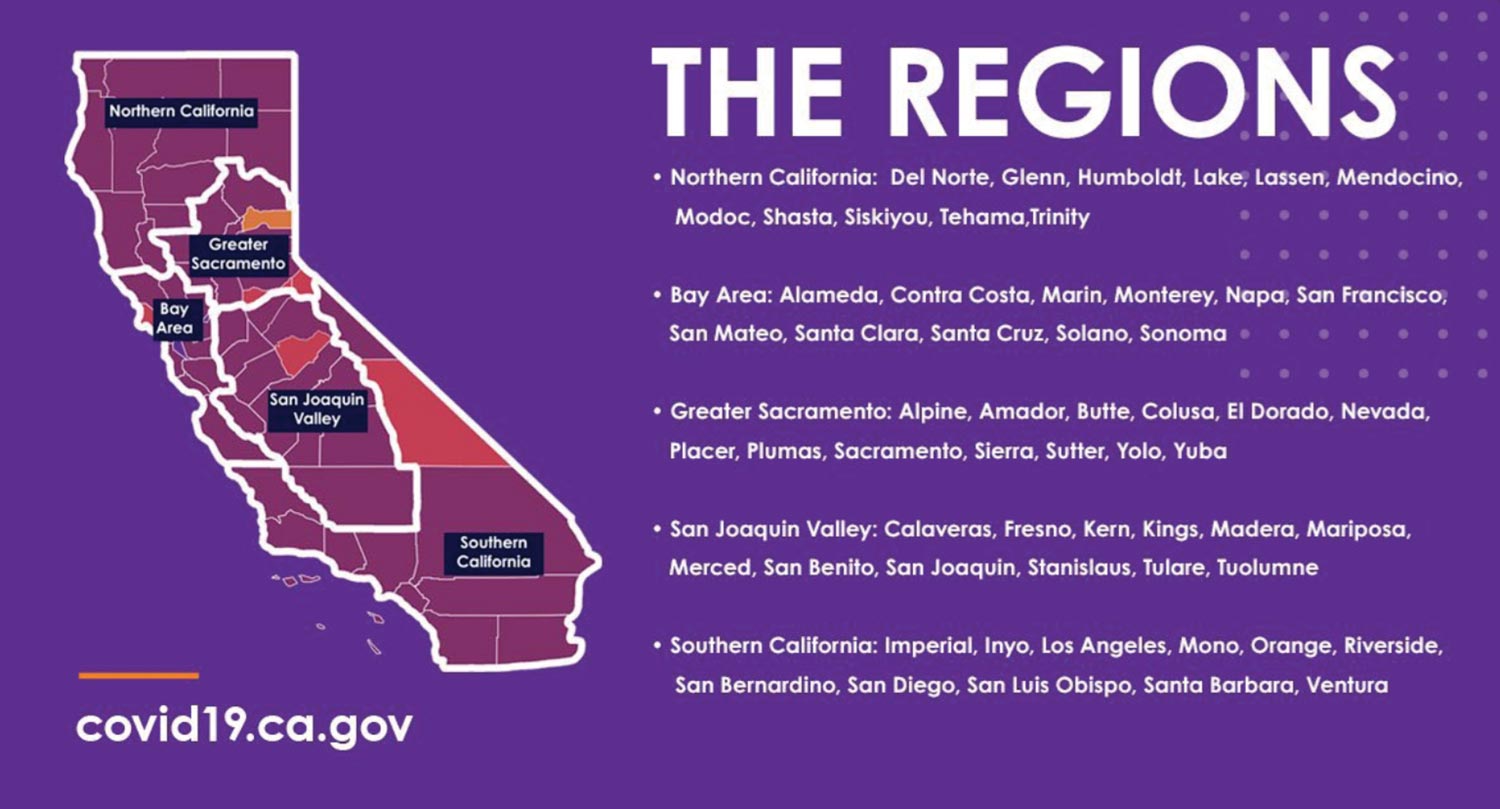
CALIFORNIA Governor Gavin Newsom announced a new coronavirus order on Thursday, December 3 which is intended to address the surging COVID-19 cases in the state.
The new order divides California into five regions and will be triggered when a region’s intensive care unit (ICU) capacity drops below 15%.
Under the new sweeping order, the state will be put into five distinct regions – Northern California, the San Francisco Bay Area, Greater Sacramento, the San Joaquin Valley and Southern California. All counties within a region are expected to abide by the stay-at-home order when that region falls into the order’s parameters.

The Northern California region includes Del Norte, Glenn, Humboldt, Lake, Lassen, Mendocino, Modoc, Shasta, Siskiyou, Tehama and Trinity counties.
The SF Bay Area region includes Alameda, Contra Costa, Marin, Monterey, Napa, San Francisco, San Mateo, Santa Clara, Solano and Sonoma counties.
The Southern California region’s counties are Imperial, Inyo, Los Angeles, Mono, Orange, Riverside, San Bernardino, San Diego, San Luis Obispo, Santa Barbara and Ventura.
The Greater Sacramento region includes Alpine, Amador, Butte, Colusa, El Dorado, Nevada, Placer, Plumas, Sacramento, Sierra, Sutter, Yolo and Yuba counties.
Finally, San Joaquin region includes the following counties – Calaveras, Fresno, Kern, Kins, Madera, Mariposa, Merced, San Joaquin, Stanislaus, Tulare and Tuolumne.
When triggered, the stay-at-home order will close the following types of businesses:
restaurants for all on-site dining, breweries and wineries, indoor recreational facilities, hair salons, personal care services, movie theaters, museums, cardrooms and casinos, family entertainment/amusement centers and playgrounds.
Hotels may remain open to provide critical infrastructure support, while churches and places of worship can hold outdoor services. Retail stores and shopping centers can stay open indoors, but with only 20% capacity.
Film production and other entertainment can continue as well as professional sports, but without live audiences.
As for schools, K-12 students will not be affected by the order. Educational institutions which are open for classroom instruction will remain able to do so.
People in a region where the stay-at-home order gets enforced will have to, as much as possible, limit travel and mixing with other people outside their household. Like the stay-at-home order issued early this year, people from the same household will be allowed to go outside for physical activity or exercise. The order will also still allow people to continue with essential activities, which includes going to the grocery, going to the doctor, and picking up takeout.
Once an order gets triggered for a region, the stay-at-home order remains in effect for at least three weeks.
So far, no region falls within the parameters of the new stay-at-home order, although Gov. Newsom indicated that that may change within a week or so.
Businesses within a region that falls into the new stay-at-home threshold will have 48 hours to comply with the mandate.
According to an article in The San Diego Union-Tribune, San Diego county will be lumped with ten other counties in the regional divisions that have significantly less bed availability than San Diego.
In the article, it showed that San Diego County as of Tuesday, December 1 does not meet the ICU threshold for the regional stay-at-home order, stating that “539 of 853 local licensed intensive care beds were occupied, 38 percent of them by COVID-19 patients. It’s tighter for current bed capacity, which is estimated at 696 beds which would give San Diego a current occupancy rate of 77 percent, still 23 percent away from the 15 percent threshold.”
The regional strategy is intentionally designed to make sure that neighboring counties have the capacity to help each other out, according to California secretary of health and human services Dr. Mark Ghaly the article pointed out.
Currently, San Diego is in the purple tier in the most recent plan unveiled by the state (Blueprint for a Safer Economy in the covid19.ca.gov website) which allows for most businesses to provide for outdoor operations and cease indoor services. San Diego is one of 51 counties in the purple tier in the state.
Under this tier, which is also referred to as Tier 1, retail stores and bookstores can open with a maximum 25% capacity, while museums, zoos and aquariums can open outdoors only with modifications. Places of worship, gyms and fitness centers can offer services but only outdoor.
Also under the purple tier, breweries, distilleries and bars that do not serve or provide meals must close. Groceries, which are considered essential businesses, can continue to operate at 50% capacity. Schools that have not opened in any capacity, meanwhile, must keep their campuses closed with the certain exceptions.




